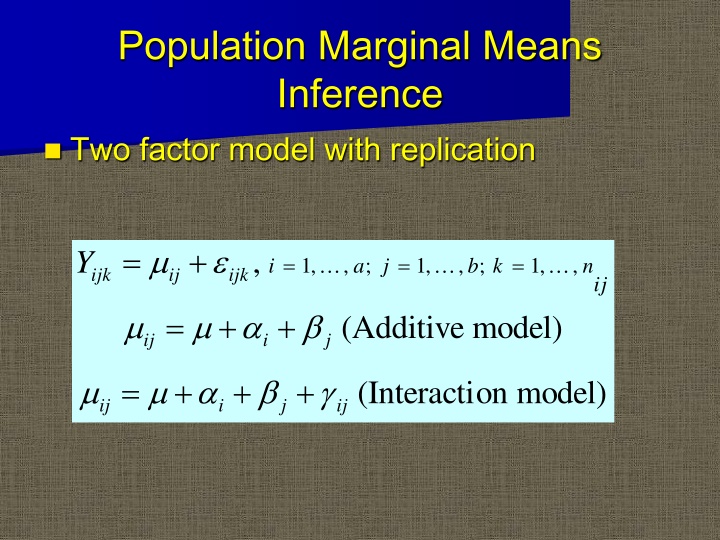
Inference and Testing for Two-factor Population Marginal Means
Explore concepts and methodologies for conducting inference and hypothesis testing on population marginal means within a two-factor model with replication. Discover insights into additive and interaction models, expectations of marginal sample means, hypothesis testing scenarios, and more.
Download Presentation

Please find below an Image/Link to download the presentation.
The content on the website is provided AS IS for your information and personal use only. It may not be sold, licensed, or shared on other websites without obtaining consent from the author. If you encounter any issues during the download, it is possible that the publisher has removed the file from their server.
You are allowed to download the files provided on this website for personal or commercial use, subject to the condition that they are used lawfully. All files are the property of their respective owners.
The content on the website is provided AS IS for your information and personal use only. It may not be sold, licensed, or shared on other websites without obtaining consent from the author.
E N D
Presentation Transcript
Population Marginal Means Inference Two factor model with replication = + , Y = = = , 1 , ; , 1 , ; , 1 , i a j b k n ijk ij ijk ij = + + (Additive model) ij i j = + + + (Interacti on model) ij i j ij
Population Marginal Means ij ( ) j = = PMM . i i b ij ( ) = = i PMM . j j a ( ) ij = PMM ij , ij i j = = ( ) PMM .. ab
Expectations of marginal sample means n ij ij ( ) Y i ~ j = = E .. . i n . i n ij ij ( ) . Y ~ = = i E . . j j n . j ~ ~ n n n . . ij ij j j . . i i ( ) ... Y ~ , i j j = = = = i E .. n n n .. .. ..
Null hypotheses for two-way model How do we conduct hypothesis testing? Usual hypotheses: : H 0 . .. A i : H 0 . .. B j + + : ( ) ( ) H 0 * .. . .. . .. B A ij i j + . . .. i j
Hypothesis testing: balanced case In the balanced case, testing E : is .. the Y same testing as H 0 . Y A i ~ : ) .. : H E 0 .. ... A H i ~ ( 0 . A i
Hypothesis testing: unbalanced case For the example in the text (n31=5; n1.=18=n2.; n3.=17), a test that the expectations of the sample marginal means are equal would test: : . 2 . 1 0 = = A H ( ) 17 + . 3 . 3 31 The discrepancy is modest here, but can lead to unusual tests in other contexts.
Type I-Type IV testing We will study inference for both the additive and interaction model Tests for the additive model are actually harder to derive than for the interaction model Sequential analyses (Type I and Type II analyses) can be misleading Type III analyses are appropriate for both
Additive Model-Type I testing The usual numerator for testing HoA, based on LS estimates of a model with A alone, will no longer be appropriate: = i 1 ( ) a 2 = SSA n Y Y . .. ... i i This is actually the basis of the Type I hypothesis test statistic for A (if A is tested first), and tests ~ : i A H ~ 0 . ..
Population Marginal Means Additive Model We base a test on: a = i 2 = . , , where , minimize SSA n i i i j 1 ( ) i,j,k 2 Y ijk i j The direct minimization is difficult, but does test the correct hypothesis i 0: A H . ..
Additive model-Example Yandell uses reduction in SS formulae to derive the same tests, but these still require LS estimation SAS example
Population Marginal Means-- Interaction Model Under the interaction model, correct test statistics are actually easier to compute. Appropriate estimates of PMMs would be: i.=1 . j=1 ..=1 j i i, j ij ij ij , , , b a ab where ij= y ij
Partition of total error Consider the partition: ( )+ . j .. ( )+ yijk ij ( )+ ) yijk ..= i. .. ij i. . j+ .. (
Interaction Model-Type III hypotheses These deviations form the basis for the straightforward Type III SS seen in Table 10.3 Type III SS test the usual PMM hypotheses, but they are not additive
Interaction Model-Type I hypotheses Type I SS are additive, but tests on A, and then on B|A, are odd We already discussed HOB|Awill test (for Type II SS as well): ~ i ~ : H . .. oA nij n. j i . j= i., which is neither .. nor ..
Interaction model-Example SAS Example n11=2, n12=3, n13=1, n21=2, n22=2, n23=2 We can study contrasts that SAS uses to test Type I, Type II, and Type III hypotheses under both additive and interaction models.
Missing Cells Inference In the additive model, Type III hypotheses are reasonable provided the design is connected For the interaction model, there is little we can do
Missing Cells Inference-Example Type III SS often test uninteresting hypotheses Type IV SS test accessible hypotheses, but may ignore much of the data in doing so Worksheet example
Missing Cells Inference-Yandell s approach Yandell Suggests Type IV-style contrasts for testing Suggests analyzing non-empty cells as a one- way effects model




















